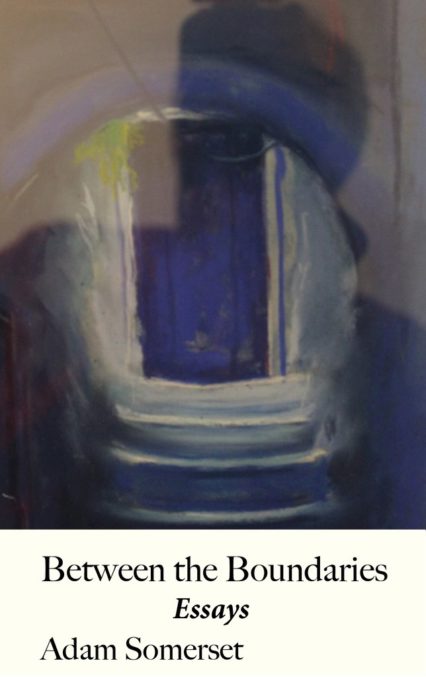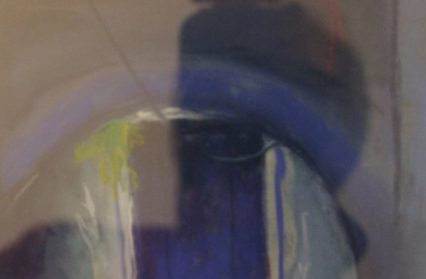Nigel Jarrett reviews a collection of essays from Adam Somerset called, Between the Boundaries that range over art and technology, the world of beavers, the Hay Festival, and consideration of the benefits of war, among many other subjects.

At a time when writing intended for publication in book form is usually fiction, lengthy non-fiction or poetry, the prospect of an essay collection whose contents have not previously appeared in a print or digital magazine is rare. But when Adam Somerset explains that the twenty-six essays in Between the Boundaries treat subjects that ‘came my way over the course of a year’ he is almost defining what essays should be and demonstrating that they can be written and kept by. Not that he stood still while waiting for their arrival; far from it. They were in place and may have seen him coming.
An essay should never be knowingly relevant or topical, which is why it can be about the disasters (or benefits) of war, the discovery of a Roman coin in a field, or a meditation on what a goldfish might be thinking, if anything – especially if anything. The subject of an essay should be the author or the author in contemplation of matters weighty or whimsical. In an essay collection, the reader looks for consistency of effort, of the ‘attempt at knowing’, if not equivalence of outcome. For many, an essay should be succinct and quirky. An essay ends when the essayist decides enough is enough, which is often quite soon.
Adam Somerset rarely strays beyond eight pages in his Between the Boundaries. That said, his essays look more outward than inward. Looking inward means the essayist has to shed detail as personal observations and feelings take over: most detail in an essay about pouting goldfish has to do with entertaining but immaterial conjecture rather than lists of content. Somerset’s collection, however, ends with two indices, one for places, one for people, and reflect the crowded niceties of the essays. They include respectively, Adelaide, in South Australia; and Clarice Beckett. Who she? the reader may ask, which is the sort of question a reader should ask of an essayist: in an essay, obscurities (but not obscurantism) are given prominence. Beckett was an Australian artist who died in 1935 aged 48. Somerset came across her in a book at the National Library of Wales – he lives in Ceredigion – and tracked her down when he was in Australia. It’s not so much that Beckett’s reputation needed advocacy but that most of her stored canvases were eaten by insects. Finding her and discovering this fact about her was serendipitous and elevated to significance, as were all the encounters in this collection, which arose from either visits or attendance at public events in 2016. Serendipity itself would be a good essay subject. Those indices, by the way, also include Cardiff, Pitzhanger Manor, Jacques Delors, and Ronnie Kray, to mention but a varied few.
As with collections of stories (less so poetry), linear reading of a book of essays at one sitting is the route to indigestion, especially when, as in Somerset’s case, the language is rich in particularity and the tone indomitably serious, though often leavened by wryness and drollery. Few collections have stated themes, because their contents represent fruit plucked from different trees at various times and for myriad reasons. So, one jumps more or less at random and with profit in this book from Clarice Beckett to beavers, with Arnold Potts in one’s sights for later investigation. An essay’s title is one of its most attractive features: the reader wonders what Waiting For A Beaver is about and why the waiting was necessary; who Mr Potts (and Clarice) was; and why one essay should be called, super-demotically, I’ll Swap You Two Buggers for A Shit.
This last is from an essay about the role of the BBC and resulted from a talk by the Beeb’s official chronicler, Jean Seaton, at Aberystwyth, and, one presumes, from a reading of the chronicles themselves. The words of the title represented an offer made during a conversation between the BBC’s Head of Drama and the director of a play by Howard Brenton and David Hare. This is a useful point at which to linger on Somerset’s view that Seaton follows John Stuart Mill in believing that debate is enlightenment of issues rather than a route to the triumph of one side of an argument or another. He (Somerset) says it is where ‘a Heideggerian sense of Enthüllung hovers’. One wishes it had flown off before settling on the page; it’s the sort of sentence that clashes with an essay’s lightness of touch, even when the subject matter is serious, or even grave. Essay subjects, and essay phraseology, should gently alight, Mouse-like, on the shoulder. But that’s a personal view.
One could nevertheless expand it and say that an essayist should not go seeking things to write about. Somerset in his essay collection Between the Boundaries is intrepid, his destinations in his year of bounty, one hopes, independent of their discovered potential as things to write about, to ‘essay’. Otherwise, there’d be an image of someone determined to write about everything and anything that moved. In the strict sense, an essayist is not a reporter; an essay is not reportage. But we should be glad he got to the beaver and of Burgweinting, Franconia, for a lovely piece that avoids any clunking connectedness – through a connection is made all the same – between beavers and humans, both of which build and whose building has extenuating consequences.
Adam Somerset’s introductory sub-title for his collection is ‘Essays in History, Art & Work.’ Beckett is art, beavers (one supposes) work, and Brigadier Arnold Potts history. In the essay devoted to the soldier, there’s an early example of Somerset’s widespread gift for vivid and concise description: the town of Denmark, in South-Western Australia, ‘flocks with parrot, ibis and kookaburra’. In nearby Kojonup, Somerset comes across a statue of Potts and relates his heroic part in the Kokoda Trail campaign, a series of battles fought in 1942 against the Japanese when Papua was then an Australian Territory. It’s a fascinating essay-type resurrection, albeit displayed in a blizzard of detail that would be less a blizzard if told in far more than seven pages. There should be no urgency about writing an essay, no struggle with space and time, no need to stuff everything in.
All that said, it sometimes seems as though it were the mark of good essayists that certain subjects, and their constituents, should seek them out, hovering before settling. ‘Butt Text’, a set of buttocks in neon by artist Olaf Breuning looks down with bare-faced cheek at Adam Somerset at the entrance to London’s Whitechapel Gallery, where an exhibition has been mounted illustrating fifty years of technology in art. Words emanate from each buttock antiphonally, which reminds Somerset of the expression ‘You’re talking out of your arse’, as it would. The Digital Superhighway is one of the best essays in the book, concluding with reflections as wise as they are deep. The specifics of A Pint, a Poet and a Portrait are welcome for anyone who’s been stupefied by a bar-room bore at the Fitzroy Tavern in London and, as a relief, turned to its décor, enumerated by Somerset as ‘engraved glass panels, a ceiling of faux-Elizabethan strap-work, squares of tendrils and bunches of grapes’, and the shades illuminating the staircases, including Christopher Wood, Roger Fry, Wyndham Lewis, Ottoline Morrell – and Dylan Thomas, a Welsh essayist’s blithe prerogative. All of this indeed could not but attract the limner. But the testimony – from Augustus John, Mervyn Levy, the artist Alfred Janes, and Pamela Hansford Johnson – is culled from the record. The story about Thomas being held upside down so that any small change could be shaken from his pockets is well known, possibly apocryphal. Essayists don’t usually do much research, relying instead on the moment and what it suggests of the unsuspectingly momentous.
War: What is It Good For? originated in a lecture by the controversial historian Ian Morris, whose meditations and researches on the inevitability of human conflict have concluded that warfare has made the world a safer place, maybe a necessary evil, and may even be good for us. No doubt we are safer comparatively when the historical canvas is explored in minutiae. One cannot help thinking, though, that Somerset’s excursions into the territory of Morris’s Big Idea in his essay collection Between the Boundaries, whatever its merits, give short shrift to genuine essay material, as when he describes the immensely tall Morris as ‘resembling one of the small pool of actors always chosen by Hollywood for the role of a diplomat or company chairman’; or when he recalls the discovery of letters from Roman soldiers in Northumbria, preserved for centuries by soaking of faeces and urine and telling of immemorial soldierly grouses: ‘Weather lousy. Beer, decent food, and fresh socks in short supply.’ Somerset, however, seems more than competent to argue for the kind of essay he writes. Like all essayists, he gravitates naturally towards certain subjects and has the knack of identifying obsessions, the elements that link them and the boundaries, often soluble, that keep them apart. As he says in his introduction of Between the Boundaries, these include the ones separating science and art, idealism and pragmatism, and involve those, such as Sir Humphrey Davy, who made the connections between them.
To read Between the Boundaries is to dip into a cornucopia with every hope of finding something interesting, the proviso being that Adam Somerset’s way of bringing up the goodies has to elbow its way into a stylistic lineage that extends from Montaigne to AA Milne to Clive James. Our paradigm goldfish essay would benefit little from a survey of the carp family, a history of aquaria, or details of a visit to a pet shop (or a history of pet shops); it might lead to over-writing. As mentioned, there is a tendency in this collection to overload, but not with anything that isn’t in itself fascinating. In any case, definitions shouldn’t be strict, otherwise, we would never have the benefit of Somerset’s roving eye, forensic interest, capacious intellectual curiosity, erudition, and considered a model of retailing. There’s little enough of it available in Wales between the covers of a book. Editors could commission him to bring back witness testimony from any part of the world and any quarter of society with every confidence that it would enthral. Maybe they should, and more often.
Between The Boundaries is available now from Parthian Books.
Nigel Jarrett won the Rhys Davies Prize for short fiction and the Templar Shorts award. He’s had two collections of short stories, a novel, and a collection of poetry published. A former newspaperman, he now writes for Wales Arts Review, Jazz Journal and others. For many years he was a music critic of the South Wales Argus. He lives in Monmouthshire and swims a lot.



 Enjoyed this article? Support our writers directly by buying them a coffee and clicking this link.
Enjoyed this article? Support our writers directly by buying them a coffee and clicking this link.







